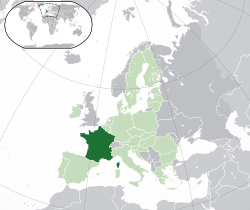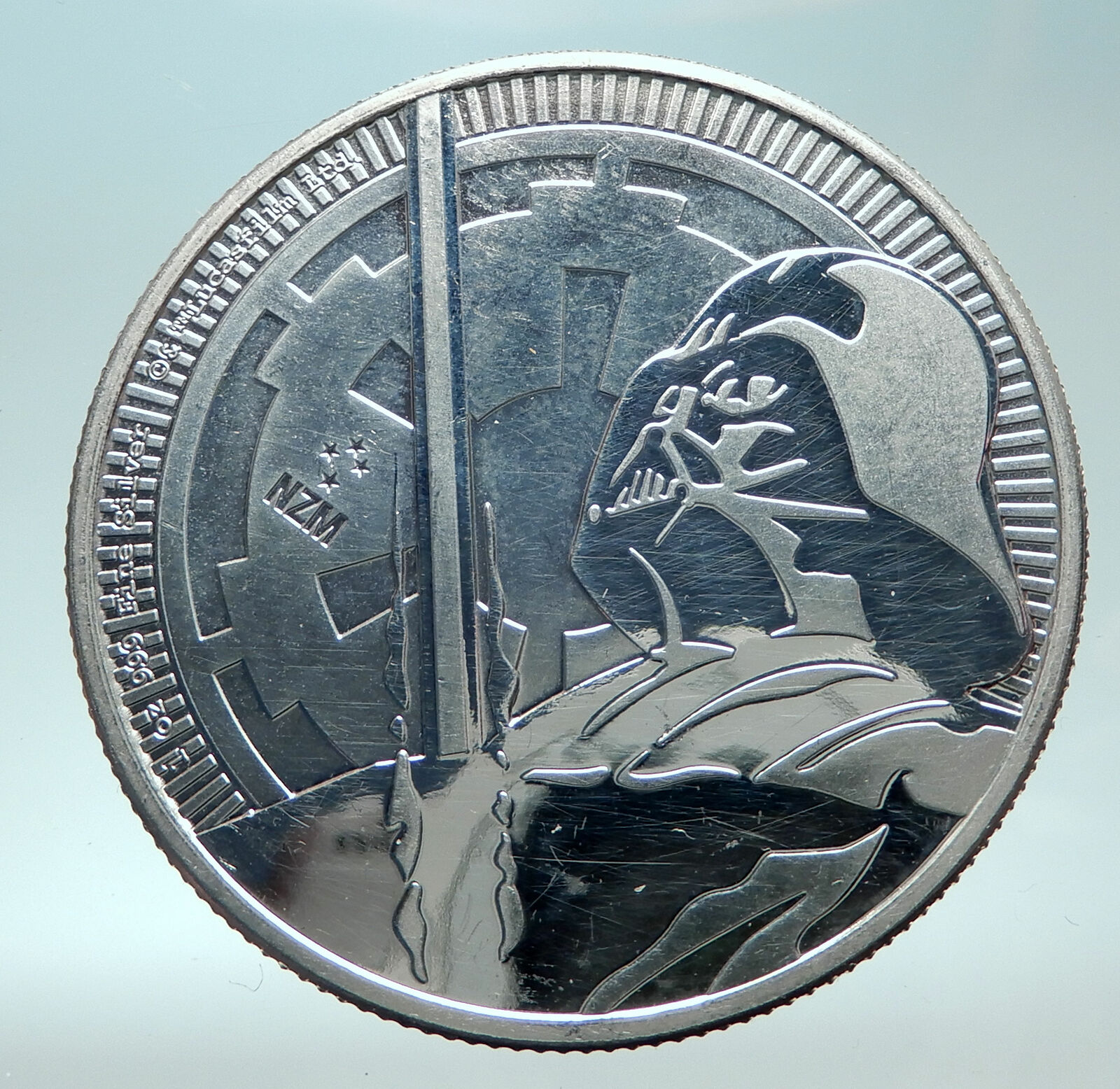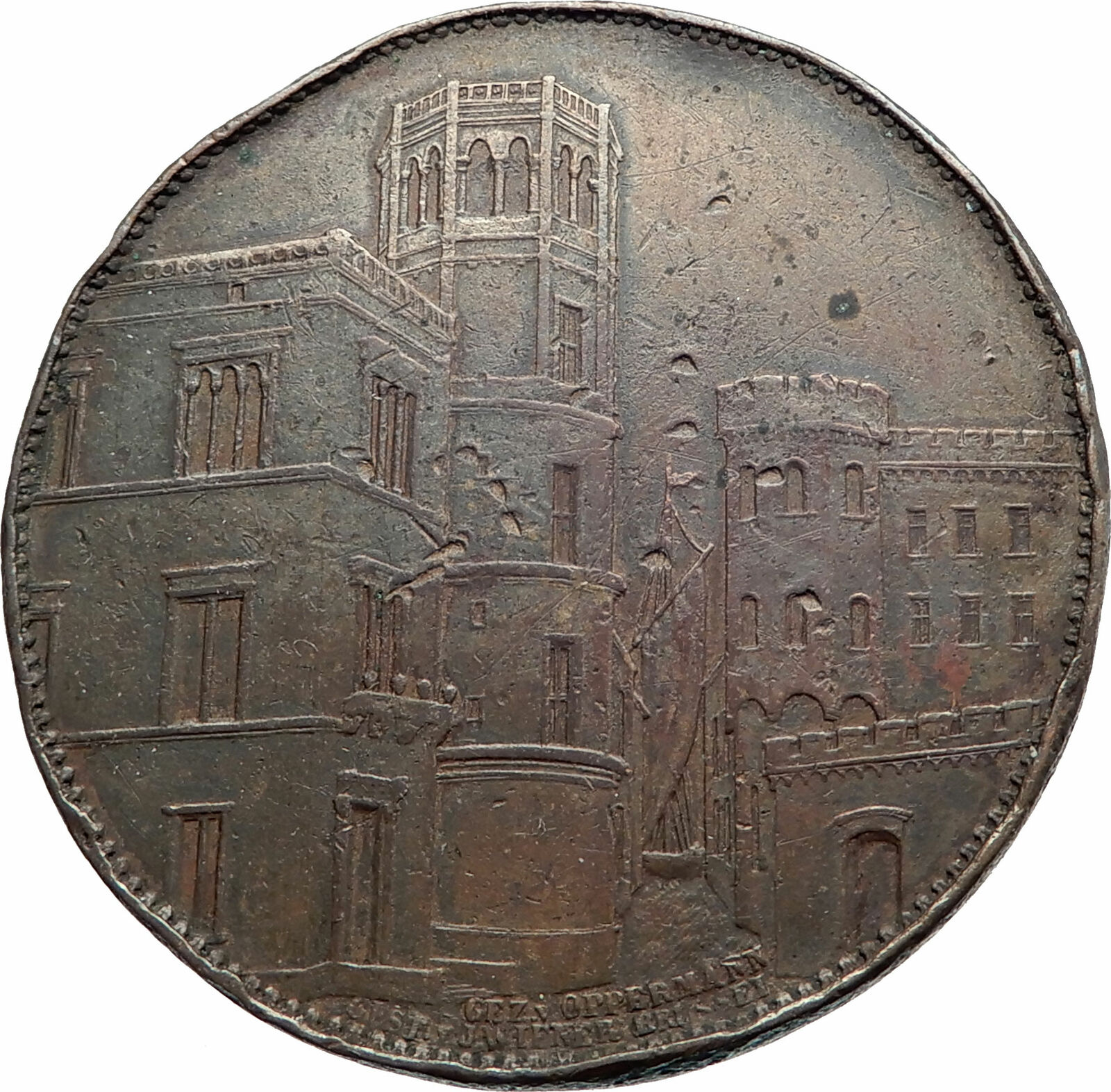|
France – Louis XIV – King: 14 May 1643 – 1 September 1715
Louis (Grand Dauphin & Son of Louis XIV) & Maria Anna Victoria of Bavaria
DYNASTIC TYPE
1680 Dated Bronze Medal 40mm (26.73 grams)
Reference: Hauser 46
Certification: NGC MS 63 BN 5720864-004
LUDOVICUS MAGNUS REX CHRISTIANISSIMUS • ; Head of King Louis XIV right.
LUDOVICI DELPHINI ET ANNAE MARIAE BABARAE CONNUBIUM M. DC . LXXX . ; Confronted heads of Louis (Grand Dauphin & Son of Louis XIV) & Maria Anna Victoria of Bavaria.
You are bidding on the exact item pictured, provided with a Certificate of Authenticity and Lifetime Guarantee of Authenticity.
 Maria Anna Victoria of Bavaria (28 November 1660 – 20 April 1690) was Dauphine of France by marriage to Louis, Grand Dauphin, son and heir of Louis XIV. She was known as the Dauphine Marie Anne Victoire or la Grande Dauphine. The dauphine was regarded a “pathetic” figure at the court of France, isolated and unappreciated due to the perception that she was dull, unattractive and sickly. Maria Anna Victoria of Bavaria (28 November 1660 – 20 April 1690) was Dauphine of France by marriage to Louis, Grand Dauphin, son and heir of Louis XIV. She was known as the Dauphine Marie Anne Victoire or la Grande Dauphine. The dauphine was regarded a “pathetic” figure at the court of France, isolated and unappreciated due to the perception that she was dull, unattractive and sickly.
Life
Maria Anna was the eldest daughter of Ferdinand Maria, Elector of Bavaria and his wife Princess Henriette Adelaide of Savoy. Her maternal grandparents were Victor Amadeus I, Duke of Savoy and Christine Marie of France, the second daughter of Henry IV of France and Marie de’ Medici, thus her husband the dauphin was her second cousin.
Born in Munich, capital of the Electorate of Bavaria, Maria Anna was betrothed to the dauphin of France in 1668, at the age of eight, and was carefully educated to fulfill that role. Besides her native language of German, she was taught to speak French, Italian and Latin. She was said to have looked forward to the fate of becoming dauphine of France. Maria Anna was very close to her mother, who died in 1676. Her siblings included Violante of Bavaria, future wife of Ferdinando de’ Medici as well as the future Elector of Bavaria, Maximilian II Emanuel.
Dauphine
Prior to her marriage to the dauphin, there was a proxy ceremony in Munich on 28 January 1680; the couple would meet for the first time on 7 March 1680 in Châlons-sur-Marne. She was the first dauphine of France since Mary, Queen of Scots married Francis II of France in 1558.
Upon her marriage, Maria Anna took on the rank of her husband as a Fille de France (Daughter of France); this meant that she was entitled to the style “Royal Highness” and the form of address Madame la Dauphine.
When she first arrived in France, Maria Anna made a good impression with her good French. When she entered Strasbourg, she was addressed in German, but interrupted the greeting by saying, “Gentlemen, I speak French!” The impression of her appearance, however, was not as good, and she was called “terribly ugly”. Others said that although she may not have been beautiful, she did have personal charm.
As soon as she married the dauphin, Maria Anna was the second most important woman at court after her mother-in-law, Queen Maria Theresa of Spain. When the queen died in July 1683, Maria Anna ranked as the most prominent female at court and was given the apartments of the late queen. The king expected her to perform the functions of the first lady at court, but her ill health made it very difficult for her to carry out her duties. The king was completely unsympathetic to her situation and accused her falsely of hypochondria.
Her husband took mistresses, and she lived an isolated life in her apartments, where she spoke with her friends in German, a language her husband could not understand. She was very close to a fellow German at court, Elizabeth Charlotte of the Palatinate, the wife of the king’s younger brother Philippe. She was said to be depressed having to live at a court where beauty was so much prized, not being beautiful herself. She died in 1690. An autopsy revealed a multitude of internal disorders that completely vindicated her complaints of chronic and severe illness.
Maria Anna was buried at the Royal Basilica of Saint Denis.
,_dit_le_Grand_Dauphin_-_Google_Art_Project.jpg/220px-Hyacinthe_Rigaud_-_Louis_de_France,_Dauphin_(1661-1711),_dit_le_Grand_Dauphin_-_Google_Art_Project.jpg) Louis of France (1 November 1661 – 14 April 1711) was the eldest son and heir of Louis XIV, King of France, and his spouse, Maria Theresa of Spain. As the heir apparent to the French throne, he was styled Dauphin. He became known as Le Grand Dauphin after the birth of his own son, Le Petit Dauphin. As he died before his father, he never became king. His grandson became Louis XV of France. Louis of France (1 November 1661 – 14 April 1711) was the eldest son and heir of Louis XIV, King of France, and his spouse, Maria Theresa of Spain. As the heir apparent to the French throne, he was styled Dauphin. He became known as Le Grand Dauphin after the birth of his own son, Le Petit Dauphin. As he died before his father, he never became king. His grandson became Louis XV of France.
Louis was born on 1 November 1661 at the Château de Fontainebleau, the eldest son of Louis XIV of France and Maria Theresa of Spain (who were double first-cousins to each other). As a Fils de France (“Son of France”) he was entitled to the style of Royal Highness. He was baptised on 24 March 1662 at the chapel of the Château de Saint-Germain-en-Laye and given his father’s name of Louis. At the ceremony, the Cardinal de Vendôme and the Princess of Conti acted as proxies for the godparents, Pope Clement IX and Queen Henrietta Maria of England. The latter was Louis’s great-aunt. It was for this occasion that Jean-Baptiste Lully composed the motet Plaude Laetare Gallia.
He was initially under the care of royal governesses, among them being Julie d’Angennes and Louise de Prie de La Mothe-Houdancourt. When Louis reached the age of seven, he was removed from the care of women and placed in the society of men. He received Charles de Sainte-Maure, duc de Montausier, as his governor and was tutored by Jacques Bénigne Bossuet, Bishop of Meaux, the great French preacher and orator, without positive result:
Louis XIV secretly nursed the same suspicious jealousy of the Grand Dauphin that Louis XIII had once shown to himself. No prince could have been less deserving of such feelings. Monseigneur, as the heir to the throne was now known, had inherited his mother’s docility and low intelligence. All his life he remained petrified with admiration of his formidable father and stood in fear of him even while lavish proofs of ‘affection’ were showered upon him. The best way for Monseigneur to do someone an injury was to commend him to the royal favour. He knew it, and did not conceal it from his rare petitioners.
Louis XIV saw to it that his son’s upbringing was quite the opposite of his own. Instead of a devoted mother and an affectionate and likeable tutor, the Dauphin had the repellent and misanthropic Duc de Montausier, who ruthlessly applied the same methods that had so disturbed Louis XIII. They annihilated his grandson.
[…] Bossuet overwhelmed his backward pupil with such splendid lessons that the Dauphin developed a lasting horror of books, learning and history. By the age of eighteen, Monseigneur had assimilated almost none of the knowledge amassed to so little purpose, and the apathy of his mind was second only to that of his senses.
It was said that when Louis was an adult, he could pass a whole day simply tapping his cane against his foot in an armchair. Nonetheless, his generosity, affability, and liberality gave him great popularity in Paris and with the French people in general. Louis was one of six legitimate children of his parents. The others all died in early childhood; the second longest-lived, Marie Thérèse of France, died at the age of five when Louis was 11.
Louis XIV, too, had a low opinion of his son:
indolent, fatuous, and dull, only the saving grace of his bourgeois morals kept him from outraging the pious people about him. Like his father he enjoyed the hunt, but that was about the only way in which this disappointing son resembled his father.
Alive especially to political considerations, the King considered various European royal daughters as possible wives for his heir, such as Anna Maria Luisa de’ Medici, Louis’ own cousin Marie Louise d’Orléans, daughter of Philippe, Duke of Orléans, and Princess Henrietta of England. According to various reports, Marie Louise and Louis were in love, having grown up with each other. However, Louis XIV decided to use Marie Louise to forge a link with Spain and forced her to marry the invalid Charles II of Spain, the Dauphin’s own half-uncle.
Louis was engaged to his second cousin, Maria Anna Victoria of Bavaria, when he was seven. She was a year older than Louis and, upon arriving at the French court, was described as being very unattractive. Nonetheless, she was a very cultured princess, and made initially a good impression upon her arrival as she was able to speak French fluently.
They were married by proxy in Munich on 28 January 1680; the couple met for the first time on 7 March 1680 in Châlons-sur-Marne.
 Louis XIV (5 September 1638 – 1 September 1715), known as Louis the God-Given (Louis Dieudonné), Louis the Great (Louis le Grand) or the Sun King (Roi Soleil), was a monarch of the House of Bourbon who reigned as King of France from 1643 until his death in 1715. Starting at the age of 4, his reign of 72 years and 110 days is the longest recorded of any monarch of a sovereign country in European history. In the age of absolutism in Europe, Louis XIV’s France was a leader in the growing centralization of power. Louis XIV (5 September 1638 – 1 September 1715), known as Louis the God-Given (Louis Dieudonné), Louis the Great (Louis le Grand) or the Sun King (Roi Soleil), was a monarch of the House of Bourbon who reigned as King of France from 1643 until his death in 1715. Starting at the age of 4, his reign of 72 years and 110 days is the longest recorded of any monarch of a sovereign country in European history. In the age of absolutism in Europe, Louis XIV’s France was a leader in the growing centralization of power.
Louis began his personal rule of France in 1661, after the death of his chief minister, the Italian Cardinal Mazarin. An adherent of the concept of the divine right of kings, which advocates the divine origin of monarchical rule, Louis continued his predecessors’ work of creating a centralized state governed from the capital. He sought to eliminate the remnants of feudalism persisting in parts of France and, by compelling many members of the nobility to inhabit his lavish Palace of Versailles, succeeded in pacifying the aristocracy, many members of which had participated in the Fronde rebellion during Louis’ minority. By these means he became one of the most powerful French monarchs and consolidated a system of absolute monarchical rule in France that endured until the French Revolution.
Louis encouraged and benefited from the work of prominent political, military, and cultural figures such as Mazarin, Colbert, Louvois, the Grand Condé, Turenne, and Sébastien Le Prestre de Vauban, as well as Andre-Charles Boulle, Molière, Racine, Boileau, La Fontaine, Lully, Marais, Le Brun, Rigaud, Bossuet, Le Vau, Mansart, Charles and Claude Perrault, and Le Nôtre. Under his rule, the Edict of Nantes, which granted rights to Huguenots, was abolished. The revocation effectively forced Huguenots to emigrate or convert in a wave of dragonnades, which managed to virtually destroy the French Protestant minority.
During Louis’ reign, France was the leading European power, and it fought three major wars: the Franco-Dutch War, the War of the League of Augsburg, and the War of the Spanish Succession. There were also two lesser conflicts: the War of Devolution and the War of the Reunions. Warfare defined the foreign policy of Louis XIV, and his personality shaped his approach. Impelled “by a mix of commerce, revenge, and pique”, Louis sensed that warfare was the ideal way to enhance his glory. In peacetime he concentrated on preparing for the next war. He taught his diplomats that their job was to create tactical and strategic advantages for the French military.
  France, officially the French Republic (French: République française), is a sovereign state comprising territory in western Europe and several overseas regions and territories. The European part of France, called Metropolitan France, extends from the Mediterranean Sea to the English Channel and the North Sea, and from the Rhine to the Atlantic Ocean. France spans 640,679 square kilometres (247,368 sq mi) and has a total population of 67 million. It is a unitary semi-presidential republic with the capital in Paris, the country’s largest city and main cultural and commercial centre. The Constitution of France establishes the state as secular and democratic, with its sovereignty derived from the people. France, officially the French Republic (French: République française), is a sovereign state comprising territory in western Europe and several overseas regions and territories. The European part of France, called Metropolitan France, extends from the Mediterranean Sea to the English Channel and the North Sea, and from the Rhine to the Atlantic Ocean. France spans 640,679 square kilometres (247,368 sq mi) and has a total population of 67 million. It is a unitary semi-presidential republic with the capital in Paris, the country’s largest city and main cultural and commercial centre. The Constitution of France establishes the state as secular and democratic, with its sovereignty derived from the people.

During the Iron Age, what is now Metropolitan France was inhabited by the Gauls, a Celtic people. The Gauls were conquered in 51 BC by the Roman Empire, which held Gaul until 486. The Gallo-Romans faced raids and migration from the Germanic Franks, who dominated the region for hundreds of years, eventually creating the medieval Kingdom of France. France emerged as a major European power in the Late Middle Ages, with its victory in the Hundred Years’ War (1337 to 1453) strengthening French state-building and paving the way for a future centralized absolute monarchy. During the Renaissance, France experienced a vast cultural development and established the beginning of a global colonial empire. The 16th century was dominated by religious civil wars between Catholics and Protestants (Huguenots).
France became Europe’s dominant cultural, political, and military power under Louis XIV. French philosophers played a key role in the Age of Enlightenment during the 18th century. In 1778, France became the first and the main ally of the new United States in the American Revolutionary War. In the late 18th century, the absolute monarchy was overthrown in the French Revolution. Among its legacies was the Declaration of the Rights of Man and of the Citizen, one of the earliest documents on human rights, which expresses the nation’s ideals to this day. France became one of modern history’s earliest republics until Napoleon took power and launched the First French Empire in 1804. Fighting against a complex set of coalitions during the Napoleonic Wars, he dominated European affairs for over a decade and had a long-lasting impact on Western culture. Following the collapse of the Empire, France endured a tumultuous succession of governments: the monarchy was restored, it was replaced in 1830 by a constitutional monarchy, then briefly by a Second Republic, and then by a Second Empire, until a more lasting French Third Republic was established in 1870. By the 1905 law, France adopted a strict form of secularism, called laïcité, which has become an important federative principle in the modern French society.
France reached its territorial height during the 19th and early 20th centuries, when it ultimately possessed the second-largest colonial empire in the world. In World War I, France was one of the main winners as part of the Triple Entente alliance fighting against the Central Powers. France was also one of the Allied Powers in World War II, but came under occupation by the Axis Powers in 1940. Following liberation in 1944, a Fourth Republic was established and later dissolved in the course of the Algerian War. The Fifth Republic, led by Charles de Gaulle, was formed in 1958 and remains to this day. Following World War II, most of the empire became decolonized.
Throughout its long history, France has been a leading global center of culture, making significant contributions to art, science, and philosophy. It hosts Europe’s third-largest number of cultural UNESCO World Heritage Sites (after Italy and Spain) and receives around 83 million foreign tourists annually, the most of any country in the world. France remains a great power with significant cultural, economic, military, and political influence. It is a developed country with the world’s sixth-largest economy by nominal GDP and eight-largest by purchasing power parity. According to Credit Suisse, France is the fourth wealthiest nation in the world in terms of aggregate household wealth. It also possesses the world’s second-largest exclusive economic zone (EEZ), covering 11,035,000 square kilometres (4,261,000 sq mi).
French citizens enjoy a high standard of living, and the country performs well in international rankings of education, health care, life expectancy, civil liberties, and human development. France is a founding member of the United Nations, where it serves as one of the five permanent members of the UN Security Council. It is a member of the Group of 7, North Atlantic Treaty Organization (NATO), Organisation for Economic Co-operation and Development (OECD), the World Trade Organization (WTO), and La Francophonie. France is a founding and leading member state of the European Union (EU).
|









 Maria Anna Victoria of Bavaria (28 November 1660 – 20 April 1690) was Dauphine of France by marriage to Louis, Grand Dauphin, son and heir of Louis XIV. She was known as the Dauphine Marie Anne Victoire or la Grande Dauphine. The dauphine was regarded a “pathetic” figure at the court of France, isolated and unappreciated due to the perception that she was dull, unattractive and sickly.
Maria Anna Victoria of Bavaria (28 November 1660 – 20 April 1690) was Dauphine of France by marriage to Louis, Grand Dauphin, son and heir of Louis XIV. She was known as the Dauphine Marie Anne Victoire or la Grande Dauphine. The dauphine was regarded a “pathetic” figure at the court of France, isolated and unappreciated due to the perception that she was dull, unattractive and sickly. ,_dit_le_Grand_Dauphin_-_Google_Art_Project.jpg/220px-Hyacinthe_Rigaud_-_Louis_de_France,_Dauphin_(1661-1711),_dit_le_Grand_Dauphin_-_Google_Art_Project.jpg) Louis of France (1 November 1661 – 14 April 1711) was the eldest son and heir of Louis XIV, King of France, and his spouse, Maria Theresa of Spain. As the heir apparent to the French throne, he was styled Dauphin. He became known as Le Grand Dauphin after the birth of his own son, Le Petit Dauphin. As he died before his father, he never became king. His grandson became Louis XV of France.
Louis of France (1 November 1661 – 14 April 1711) was the eldest son and heir of Louis XIV, King of France, and his spouse, Maria Theresa of Spain. As the heir apparent to the French throne, he was styled Dauphin. He became known as Le Grand Dauphin after the birth of his own son, Le Petit Dauphin. As he died before his father, he never became king. His grandson became Louis XV of France.  Louis XIV (5 September 1638 – 1 September 1715), known as Louis the God-Given (Louis Dieudonné), Louis the Great (Louis le Grand) or the Sun King (Roi Soleil), was a monarch of the House of Bourbon who reigned as King of France from 1643 until his death in 1715. Starting at the age of 4, his reign of 72 years and 110 days is the longest recorded of any monarch of a sovereign country in European history. In the age of absolutism in Europe, Louis XIV’s France was a leader in the growing centralization of power.
Louis XIV (5 September 1638 – 1 September 1715), known as Louis the God-Given (Louis Dieudonné), Louis the Great (Louis le Grand) or the Sun King (Roi Soleil), was a monarch of the House of Bourbon who reigned as King of France from 1643 until his death in 1715. Starting at the age of 4, his reign of 72 years and 110 days is the longest recorded of any monarch of a sovereign country in European history. In the age of absolutism in Europe, Louis XIV’s France was a leader in the growing centralization of power.
 France, officially the French Republic (French: République française), is a sovereign state comprising territory in western Europe and several overseas regions and territories. The European part of France, called Metropolitan France, extends from the Mediterranean Sea to the English Channel and the North Sea, and from the Rhine to the Atlantic Ocean. France spans 640,679 square kilometres (247,368 sq mi) and has a total population of 67 million. It is a unitary semi-presidential republic with the capital in Paris, the country’s largest city and main cultural and commercial centre. The Constitution of France establishes the state as secular and democratic, with its sovereignty derived from the people.
France, officially the French Republic (French: République française), is a sovereign state comprising territory in western Europe and several overseas regions and territories. The European part of France, called Metropolitan France, extends from the Mediterranean Sea to the English Channel and the North Sea, and from the Rhine to the Atlantic Ocean. France spans 640,679 square kilometres (247,368 sq mi) and has a total population of 67 million. It is a unitary semi-presidential republic with the capital in Paris, the country’s largest city and main cultural and commercial centre. The Constitution of France establishes the state as secular and democratic, with its sovereignty derived from the people.





